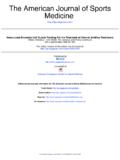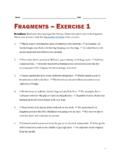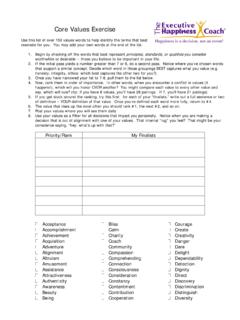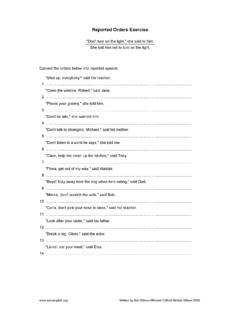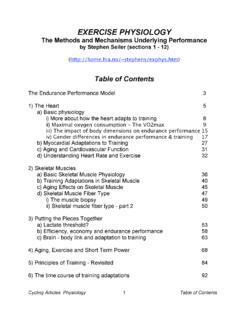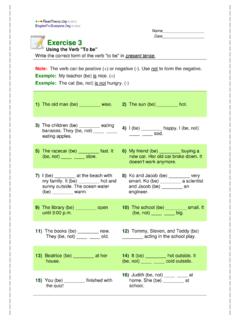Transcription of HAMSTRING EXERCISE PROGRESSION - New …
1 HAMSTRING Rehabilitation and Prevention Protocol University of Delaware Sports and Orthopedic Clinic PREVENTATIVE EXERCISE PROGRESSION FOR. HAMSTRING STRAIN. There are 4 components of a proper HAMSTRING prevention program. These are aimed to incorporate the many ways that the HAMSTRING is used in sport where it is most commonly injured; the muscle has the ability to stretch statically and dynamically, contract concentrically and eccentrically and also performs in rapid changes between the concentric and eccentric motions as in plyometric activity. **Before any activity, including stretching, it is important to warm up properly to increase blood flow to the muscles for effective stretching and to reduce the risk of injury.
2 Examples of proper warm up include jogging, biking, jump rope, jumping jacks, etc.**. Static stretching; should be performed for 30 seconds each with no ballistic movement at end range. o Pike o Hurdles left and right o Straddle o Supine HAMSTRING stretch with belt o Standing HAMSTRING stretch with anterior pelvic tilt o Splits (gymnasts, cheerleaders, figure skaters, dancers, etc). Dynamic stretching; walking dynamic stretches should be performed for as many stretches as possible within approximately 10 yards. Walking quad stretch Walking knee to chest Frankensteins Side Lunges Walking HAMSTRING stretch Helicoptors Inch Worms Stepping Backwards 1/15. HAMSTRING Rehabilitation and Prevention Protocol University of Delaware Sports and Orthopedic Clinic Leg swings these are performed stationary with one hand supported for balance.
3 Swing straight leg forward until stretch is felt and then repeat into hip extension, progressively increasing the range. Plyometrics: These are important exercises for the prevention of HAMSTRING strain due to their ability to use the HAMSTRING muscle at its greatest length and highest force. Please see plyometric program embedded in this rehabilitative program. Progressive Resistive Exercises are also required to increase the strength of the HAMSTRING to further prevent injury. Standing HAMSTRING curls Prone HAMSTRING curls Concentric HAMSTRING curls Eccentric HAMSTRING curls Romanian Dead Lifts : 2/15. HAMSTRING Rehabilitation and Prevention Protocol University of Delaware Sports and Orthopedic Clinic REHABILITATION AND EXERCISE PROGRESSION .
4 AFTER GRADE II HAMSTRING STRAIN. Notes: Muscle most commonly affected is long head of the biceps femoris, usually just proximal to the musculotendinous junction 6-16 cm proximal to the knee joint. Immobilization if required should be in the lengthened position and should not last longer than 1 week The use of NSAIDS is controversial in the first few days because of the potential for impeding healing; evidence suggests that NSAIDs have no additive effect on the healing rate. Acute Phase (3-4 times a day). Rest (immobilization in a lengthened position for no longer than 1 week, then relative rest). o No antalgia with gait: if antalgic, supplement with assistive device o Gentle stretching (pain less than 3/10). Ice in lengthened position (in long sitting with as much active pain free knee flexion and extension as possible).
5 Compression and elevation until thigh girth stabilizes NSAIDS no sooner than 2-4 days after injury Retrograde massage may be implemented for swelling control. DTM may begin when girth is stabilized Modalities- sensory Estim can be used Criteria for PROGRESSION : No increase in thigh girth measured 8 cm proximal to the patella;. SLR to 80 with an estimation of 3 or less on a numeric rating scale where 0 = no pain and 10. = maximal pain Test: The foot is plantar flexed and the examiner slowly (about 30 /s) raises the leg Subacute Phase: day 3 to >3 weeks Stretching (3-4 times/day). o Progressively increase stretch to full ROM (stretched across hip and knee). exercises. o Self stretching Begin with standing technique with anterior pelvic tilt Progress to aggressive self-stretching and partner stretches Strengthening PROGRESSION (daily).
6 O Isometric knee flexion begin with sub-maximal isometric holds at multiple joint angles (0o, 30o, 60o, 90o) and progress to maximal holds 3/15. HAMSTRING Rehabilitation and Prevention Protocol University of Delaware Sports and Orthopedic Clinic o Stool scoots Athlete sits on wheeled stool and plants heel into floor and uses HAMSTRING to propel forward. Progress with distance and to single leg. o Start with Seated concentric isokinetic exercises (CON/ECC 50-75 /s or isotonic). o Move towards higher and lower speeds with more force o Seated HAMSTRING curls Begin at 30% of 1RM of contralateral HAMSTRING 3-4 sets of 10 repetitions progress to 60%. Deep Tissue Massage (daily). o Depth and forcefulness may be increased as the need arises to reach the target tissue that may be deeper Cardiovascular fitness (up to 2 sessions per day).
7 O UBE. o stationary biking o other controlled activities Modalities prn Criteria for PROGRESSION within this phase: Complete the activity with estimation of 3 or less on a numeric rating scale where 0 = no pain and 10 = maximal pain. Complete concentric seated strengthening PROGRESSION and achieve full ROM with estimation of 3 or less on a numeric rating scale where 0 = no pain and 10 = maximal pain. Remodeling Phase: 1-6 weeks Stretching PROGRESSION (3-4 times/day). o Maintain or increase muscle length using aggressive frequent stretching (passive, self and partner stretches) encourage EXERCISE through the full ROM. Strengthening PROGRESSION (daily to every other when at power volume). 4/15. HAMSTRING Rehabilitation and Prevention Protocol University of Delaware Sports and Orthopedic Clinic o Begin more aggressive concentric strengthening Seated HAMSTRING curls 60-80% of 1RM of contralateral leg Begin with strength volume (high weight, low reps) and move to power volume (faster speeds).
8 Standing HAMSTRING curls Can be performed with machine or ankle weights. Begin with strength volume (high weight, low reps) and move to power volume (faster speeds). o Prone HAMSTRING exercises (introduces eccentric component). Start with prone curls with ankle weights at 30% of 1RM of contralateral HAMSTRING 3-4 sets of 10 repetitions. Progress to strength and power volumes Progress to eccentric contraction via ankle weights with concentric assistance or manual resistance. o Manual prone eccentric/concentric HAMSTRING curls Athlete lays prone while manual resistance is applied distally. He/She contracts the hamstrings concentrically against resistance and continues to contract as resistance increases to bring the foot down eccentrically.
9 This allows for the athlete to be strengthened in pain free range and more focus can be paid to weakness in certain ranges, especially closer to full extension. o Prone leg dropping Athlete lies prone with knee flexed and foot in air. Gently move foot back and forth to stimulate relaxation. Drop the foot suddenly and have athlete catch the foot as soon as they feel it released. Progress to 1 or 2 lbs and/or push leg instead of drop to increase loading. 5/15. HAMSTRING Rehabilitation and Prevention Protocol University of Delaware Sports and Orthopedic Clinic This helps the athlete regain their proprioceptive sense that may have been lost secondary to weakness and immobilization from injury. With a heightened proprioceptive sense the athlete may be able to better detect the position of the HAMSTRING , which may decrease their risk of re-injury.
10 O Progress to seated eccentric HAMSTRING curl Load weights at 120 % of 1 RM of single leg HAMSTRING curl. Use two legs for concentric motion. Release one leg and allow single leg to release weight in a controlled fashion. Progress weights appropriately. Progress to prone position o Progress to prone isokinetics (CON/ECC beginning at high speeds (240/240) and gradually decreasing the speed (120, 90, and 60), through pain free range. Progress to strength and power volumes o HAMSTRING ball rolls The athlete lays supine with a ball under his/her leg(s). Roll the ball towards the body by flexing the leg while maintaining trunk and hip stabilization. This EXERCISE can be progressed from 2 feet using theraball 1 foot using theraball 1 foot using medball, other foot in air.)
